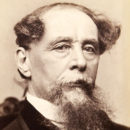When We Replicated Charles Dickens
by Bruce Boston
When we replicated Charles Dickens we were not sure
what to expect. You could never be sure with the artistic
types. We had only succeeded after a fashion with
Edgar Allan Poe, Rimbaud, and Raymond Chandler.
Until his untimely and inexplicable suicide, Chandler
Two turned out one mystery thriller after another,
all of them fine historical examples for aficionados
of the hardboiled genre.
Poe Two proved as self-destructive as his predecessor.
He could not learn to exist within our forms and
functions. He was aborted. Though a Poe Three with
significant genetic alterations has been proposed.
Rimbaud Two fled the security of our sanctum and
rumor has it he has been spotted more than once
roaming the Torched Lands, shouting perverse verses
into the rad wind. The search for his retrieval and
subsequent rehabilitation has been abandoned.
Charles Dickens was a different matter all together.
Some claim the sample had been corrupted. We can assure
you this was not the case. The bone scrapings were
taken directly from the grave and all regulatory procedures
were followed to the letter. The developing corpus
experienced an accelerated virtual scenario that
embodied our knowledge of his life and times.
The Dickens replicant adjusted admirably
to the limits of his confinement.
He retired to his study to spin heart-wrenching
tales of great magnitude that have found a receptive
audience beneath the Dome.
It was Dickens Two who reminded us with the compelling
illusions of fiction just how brutal and precise we
have become.
__________
Bruce Boston is the author of forty books and chapbooks, including the novel Stained Glass Rain. His stories and poems have appeared in hundreds of publications, including the Pushcart Prize Anthology, Year’s Best Fantasy and Horror, and the Nebula Awards Showcase. He lives in Ocala, Florida, with his wife, writer-artist Marge Simon. For more information, please visit: http://hometown.aol.com/bruboston.
Copyrighted by the author unless otherwise noted.
Art Director: Bonnie Brunish

